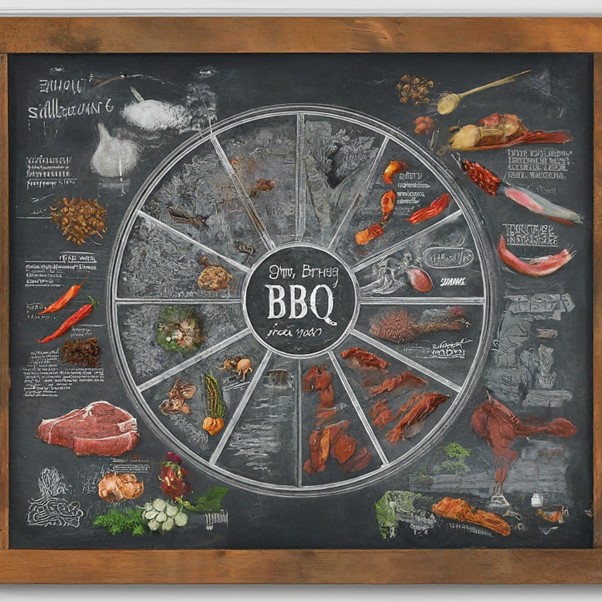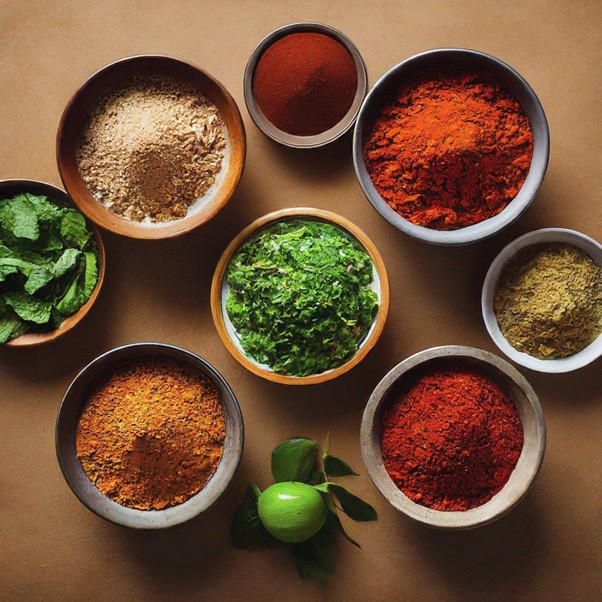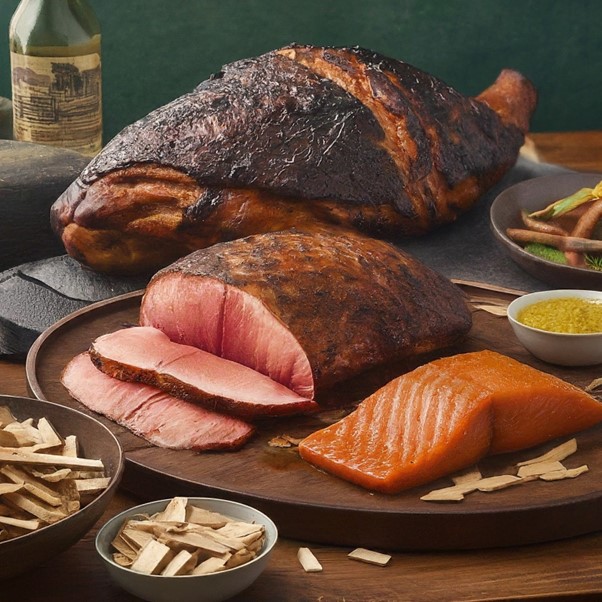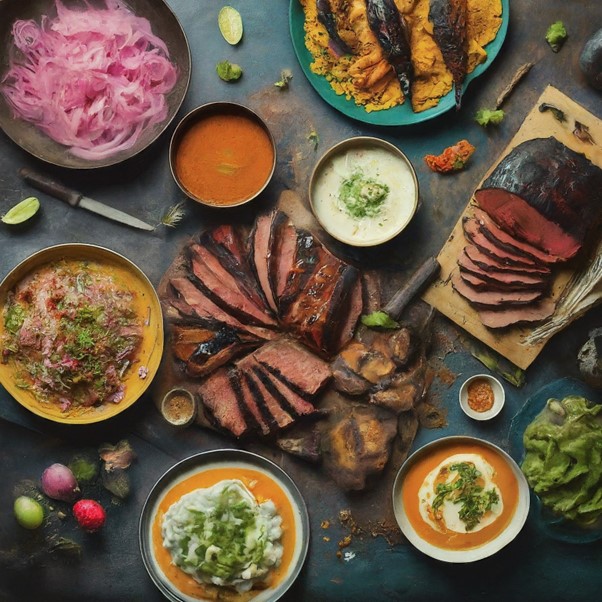
Image via Dall-E
BBQ is more than just cooking food over a grill. The layers upon layers of flavour, each delicately balanced, require a certain culinary expertise. But don’t let that put you off, because, in this article, we’ll cover the basic principles of flavour combination, exploring uncommon pairings from exotic spice rubs to innovative marinades.
Exquisite flavour combinations are achieved through experimentation and lots of practice, with some basic knowledge of what’s known as a flavour matrix, serving as both a guide and an inspiration for culinary creativity. As enthusiasts and innovators at BillyOh, we strive to learn all there is to know about barbeques. In our blog, you can find BBQ tips and tricks on how to smoke your meats and veggies to perfection. By understanding these relationships between flavours, you can improve your culinary skills, create more dynamic dishes, and even rescue dishes that may have been overly seasoned.

Image via Gemini
The Art of BBQ Flavour Profiling
A flavour profile refers to the varying tastes detected when eating food. It comprises a range of taste sensations, such as sweetness, sourness, saltiness, bitterness, and umami. For BBQ, there are some fundamental flavour profiles to consider:
- Smoky: Naturally, smokiness is expected with a charcoal BBQ. However, different kinds of smokiness can be achieved through various methods, including smoked ingredients like paprika or chipotle but also the type of wood you use.
- Sweet: Brown sugar, molasses and honey are common ingredients in a BBQ as they balance out the tanginess and spices, and create a beautiful, caramelised crust.
- Tangy and Sour: Vinegar, lemon juice or mustard, can add a delightfully tangy and refreshing dimension to your BBQ flavour profile.
- Spicy: If you’re not afraid to bring some heat to your BBQ, adding some chilli powder or cayenne pepper can spice up your dish.
Imagine all these flavour components on a “flavour wheel”, a diagram that helps grill masters understand how various flavours interact. A BBQ flavour wheel is all about categorizing and understanding the complex flavours and aromas that can be imparted through the following woods, spices, marinades, and cooking techniques.
Wood Smoke
Authentic BBQ flavour comes largely from the smoke. Various types of wood give off different aromas and tastes. Since BBQ often involves smoking meat for long periods, these subtle differences in smoke flavour become quite noticeable. Hickory and mesquite, both able to produce delicious smoked meat are highly popular options.
Cooking Techniques
When cooking your BBQ, what’s most important is that you don’t use too much smoke wood. Too big a fire can result in a less than desirable sooty, bitter taste. But don’t let that stop you from giving your BBQ meat enough time over a low, steady heat source. If you rush the cooking time, you won’t get the most out of the smoked flavours and the dry rub.
A decent-sized smoker BBQ will fit your desired quantity of meat with enough space for airflow and reliable temperature control. But the reality is, anything can be a smoker! Repurposing old furniture such as a fridge or file cabinet can produce just the same results. However, it can’t hurt to be open to using some advanced equipment like pellet grills, sous-vide machines, and digital thermometers.
Spices, Herbs & Marinades
By using BBQ rubs and marinades, you can infuse your meat with a variety of exciting flavours. Rubs are dry mixtures that can be sprinkled onto the meat, while marinades are liquid mixtures that the meat is soaked in. Both rubs and marinades typically contain three ingredients: acids, fats, and seasonings/flavourings. The most common acids used are lemon juice, vinegar, and yoghurt, while fats include olive oil, butter, and mayonnaise. As for seasonings, the options are endless! You can use herbs, spices, garlic, onions, peppers, and even fruits. Salt and sugar should also be included in small quantities.

Image via Gemini
Unconventional Spice Rubs
While American BBQ may be your primary source of inspiration, exploring unique rubs that borrow from international flavours can refine your BBQ flavour profile. (As a side note, be careful when handling unfamiliar ingredients as they may contain allergens!)
- Thai BBQ or “Mod Kra Ta” pairs citrusy flavours like lemongrass and kaffir lime leaves with garlic and coriander in aromatic marinade sauces. It also includes delicious dipping sauces like nam jim jaew, a spicy tamarind sauce, and peanut sauce.
- Filipino BBQ meats of choice, often pork and chicken, are marinated in calamansi, a small citrus fruit native to the Philippines, providing acidity and citrusy undertones, as well as annatto seeds and complemented by banana ketchup.
Lavender and Rosemary Rub for Pork
Lavender brings a unique, mildly floral aroma that combines wonderfully with rosemary’s piney, earthy scent. Add a hint of brown sugar to balance these flavours with a subtle sweetness and accentuate the pork’s natural taste.
Spicy Chipotle and Cocoa Rub for Beef
This rub combines smoky, spicy, and subtly sweet flavours to create a mouthwatering taste experience. The chipotle powder adds a smoky heat, while the cocoa provides a rich and slightly bitter counterbalance.
Moroccan-Inspired Ras el Hanout Rub
This Moroccan rub is incredible due to its combination of spices. Cumin, coriander, ginger, and paprika are the foundation, giving a unique blend of earthiness, warmth, sweetness, and a touch of spice. Turmeric adds complexity with its bitterness, while cinnamon provides a hint of sweet, woody elegance. To elevate the rub, cayenne pepper can be added, bringing out the richness in meats like lamb or chicken and roasted vegetables.
Innovative Marinades That Transform Flavours
As you can see, marinades feature in these recipes just as much as spice rubs. They are equally important in enhancing the flavour of food, as well as tenderising tougher cuts of meat. Here are just a few varieties of marinades to spark your imagination:
Fruit-based Marinades
Certain fruits, such as pineapple, figs, and kiwi, possess an enzyme called papain, which can break down proteins, specifically in meat, releasing juices. These juices help keep the meat moist during the smoking process, resulting in a tender and flavourful smoked meat dish. The fruits’ natural sugars caramelize under the heat of the grill, forming a deliciously crispy and flavourful crust on the meat’s exterior.
Tea-infused Marinades
Tea’s subtle flavours pair wonderfully with many meats and seafood. But what’s extra special about black tea is the tannins it contains, which have natural tenderizing properties. Black tea’s rich and intense flavours also complement meats and seafood, adding traces of smoky, malty, fruit or spicy flavours depending on the tea variety.
Alcohol Flavors
Guess what else contains tannins? Alcohol. Different types of alcohol, such as beer, wine, whiskey, or rum, can add their unique tastes. For example, a robust, fruity full-bodied red wine or lighter white wine marinade will naturally taste different to the subtle yeasty undertone of beer. For non-alcoholic options, consider soft drinks like coke or root beer, or perhaps non-alcoholic beers or wines if you want a similar taste profile.

Image via Gemini
Wood Chip Flavors: Beyond the Basics
By understanding the unique properties of each type of wood, you can create layered smoke flavours tailored to specific dishes. For instance, a combination of pecan and applewood may be ideal for a sweet and smoky pork shoulder. Let’s delve into smoke wood flavour profiles in more detail:
Fruitwoods
- Applewood: Its sweet, mellow smoke is a classic choice for pork and poultry, lending a subtle fruitiness that enhances without overpowering the natural flavours of the meat.
- Cherry Wood: This wood imparts a mild, sweet, and slightly tart smoke, ideal for adding a touch of colour and a gentle fruity aroma to both red meats and poultry, creating dishes with a visually appealing, rosy hue.
Nut Woods
- Pecan Wood: Offering a sweet, gentle, nutty smoke that’s richer than fruitwood but less intense than hickory or mesquite, pecan wood is excellent for creating a subtly smoky background that enhances the meat’s natural flavours without dominating.
Specialty Woods
- Jack Daniel’s Whiskey Barrels: Using oak wood casks that have had whisky soaked in them for years can infuse a wonderfully unique, boozy flavour into meats that can stand up to strong flavours, such as beef brisket or thick pork chops.
- Alder Wood: Known for its light, slightly sweet smoke, alder wood is traditionally used for smoking fish, especially salmon. Its delicate flavour also pairs well with poultry and can be a great choice for those seeking a more subtle smoky taste.
- Grapevine: Grapevines produce a lot of smoke, which imparts a robust, fruity flavour reminiscent of wine. This choice is excellent for grilling lamb, and poultry, or even for adding complexity to grilled vegetables.
- Maple Wood: With its mild and slightly sweet smoke, maple wood is a fantastic option for pork and poultry. It can add a subtle sweetness that complements the savoury flavours of the meat, perfect for dishes that balance sweet and savoury notes.

Image via Gemini
Pairing Foods with Uncommon BBQ Flavors
Meat Pairings:
In BBQ, there are technically no limitations as to which type of protein can be used. While beef and pork are the preferred choices, as long as your meat is tough and fatty, it will withstand the long cooking times without becoming dry. Meats can be paired with just about anything – sweet, spicy, smoky, tangy, you name it. Consider using sour and tangy flavours that can cut through the fattiness of BBQ meats. This will add a real zesty kick that refreshes the palate.
Vegetable & Vegan Options
Grilling or barbecuing vegetables and fruits yields unique and flavourful results. While root vegetables gain a pleasant sweetness and caramelized exterior, cruciferous vegetables like Brussels sprouts and kale develop an intense flavour with a charred balance. Mushrooms are great for soaking up sauces and seasonings, becoming richly flavoured, and grilled corn on the cob is tender and smoky, perfect with butter or spices. You can’t go wrong with tofu and plant-based meats either, as they’ll absorb all the flavours of your marinade or rub.
Seafood Surprises
Seafood often benefits from a swift searing over direct heat to maintain moisture while achieving a crispy exterior. Delicate fish can be grilled on cedar planks to add a subtle smokiness while shielding it from intense flames. When cooking thicker fish cuts or whole fish, use indirect heat and smoking to infuse them with a rich smokiness without overcooking. Stuffing the fish’s cavity with herbs and lemon slices imparts an aromatic flavour. For a unique twist, consider a sweet and spicy glaze such as a blend of honey, and chilli flakes to create a caramelized crust bursting with flavour.

Image via Dall-E
Practical Tips for Experimentation
When experimenting with BBQ flavours, begin by introducing simple adjustments to your traditional recipes, such as incorporating a new spice into your rub or adding an unconventional ingredient to your marinade. Understanding the interaction of flavours is key. Use the flavour wheel to learn how sweet, sour, salty, bitter, and umami flavours work together.
Be sure to modify your cooking techniques as well. Different ingredients have different reactions to heat, so you may need to adjust the temperature, cooking duration, or even the cooking method to get the best results. Notice how these changes affect the texture and flavour to change your approach accordingly. Through this mindful experimenting process, you can find new and exciting combinations that could become your new favourites.
Conclusion
Our BBQ journey has taken us on an exploration of unique flavour pairings in spice rubs, marinades, and wood chip mixes, pushing the boundaries of traditional BBQ. At Billyoh, we’re passionate about BBQ and sharing our knowledge. We encourage you to not just read about these flavour combinations but to try them out in your own backyard. Experiment with unusual spice rubs, and innovative marinades, and share your discoveries and experiences with our community. Explore our range of BBQ smokers, fire pits and other BBQ accessories today to get started on your culinary adventure.
References & Further Reading
The science of flavour pairing:
https://www.ethanchlebowski.com/kitchen-reports/qowygc647epm72ovgv59jnuusvh46m
https://www.cooksmarts.com/articles/study-flavor-profiles/
https://krghospitality.com/2023/10/06/the-science-of-flavour-pairing/
The impact of wood smoke:
https://johanjohansen.dk/2015/10/15/beginners-guide-to-bbq-part-1-bbq-basics/
https://www.outdoorgrillingcompanybbq.com/bbq-smoke-secrets-how-wood-types-shape-taste
Safe BBQ practices:
https://www.food.gov.uk/safety-hygiene/bbq-food-safety
https://www.national-accident-helpline.co.uk/news/post/barbecue-safety-tips
